Many Languages, One Classroom: Supporting Children in Superdiverse Settings
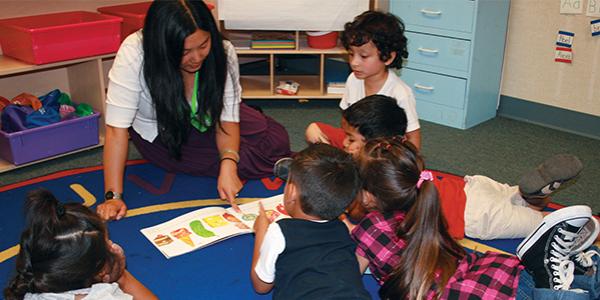
You are here
This is the first of two articles offering strategies for teaching children in classrooms where a variety of home languages are spoken.
Matthew, a monolingual English speaker, and two assistants who speak Spanish and Tagalog, teach in a classroom with children who speak five different home languages. The classroom buzzes with new songs and phrases in English and sometimes words of comfort in each language. Carefully placed pictures and labels help children see and interact with key words and items from all their cultures. In one corner of the classroom, Matthew welcomes a new parent and arranges a family language and cultural background interview.
Are you one of the many teachers today with children in their classrooms who speak a number of different languages and are just beginning to learn English? Teaching in a classroom like this is a challenge! How in the world do you go about it?
You need concrete strategies you can use to support children’s language development in both English and their home languages. Of course, it’s ideal when teachers speak the children’s languages. But in superdiverse classrooms, that’s unlikely to be the case.
Here, we offer strategies from an approach we call personalized oral language learning (POLL). Teachers who have tried them find these strategies especially useful for supporting the learning and development of children in classrooms with a range of languages.
Personalized oral language learning
As centers and schools serve more and more children who speak little or no English at home—and as we recognize the many benefits of children retaining their home languages and cultures—teachers often ask us, “What are the specific strategies I should use to support my dual language learners?” POLL answers this question with three types of assistance: (1) family engagement, (2) environmental supports, and (3) conversation and interaction. In this issue of TYC, we address the first two strategies. In the February/March 2019 issue, we’ll explore strategies for fostering conversations and interactions with children who are dual language learners.
Family engagement
Start by gathering information about each child’s experience in the home language and in English. This is a critical step. We highly recommend that you meet with families in a personal, face-to-face interview to collect this information—along with information about the family’s background and their shared interests and activities. (For a sample interview about family languages and interests, see below.) A personal meeting is much more effective than sending home a questionnaire or having an informal conversation. This is not the only time for the teaching team to meet with families, but it’s the beginning of a relationship and dialogue focused on the importance of both home language and English language development.
Through this type of teacher–family collaboration, you can plan together how to weave linguistic and cultural information into activities at school and at home. For example, families can have conversations with their children in their home languages on the topics/themes and new words shared by the teachers each week. Interviews and ongoing communication also provide perfect opportunities for you to invite parents and other family members to volunteer in the classroom!
As the school year progresses, be sure to keep families involved in the classroom’s storybooks, themes, and learning concepts. Communicate with them in the languages they are most comfortable speaking (you may need to use an interpreter). Try reaching out in different ways, such as frequently sending home two-way journals for families to read, write in, and return; having regular small-group coffee chats with parents before the school day; emailing, texting, and holding frequent casual conversations at pick up and drop-off; and scheduling oneon- one conversations. Your reminders will reinforce families’ awareness of the importance and benefits of their using the home language in everyday activities, having rich conversations with their children, reading, telling stories, and playing.
The home languages of the children in Ding’s family child care program include Spanish, English, and Vietnamese. Ding’s home language is Vietnamese, and she speaks English fluently.
Ding knows that one child’s family owns a food truck. She has invited the family to park the truck outside her home one morning to share food items with the children and show them steps the family takes in preparing and selling food. Ding plans vocabulary activities based on food prices and menus from each child’s culture. She chooses related books in all three languages and prepares materials for the children to use in creating a food truck in the dramatic play area.
Environmental supports
When you create a warm, nurturing environment, one that welcomes children and families, you send the message that you value and respect them, their language, and their culture. When your classroom includes the home languages and cultural backgrounds of all the children and families, they see and feel that they are natural and important parts of classroom activities. You’ll soon notice positive results: young dual language learners will develop confidence, communicate their thoughts and feelings more readily, concentrate better, and learn more.
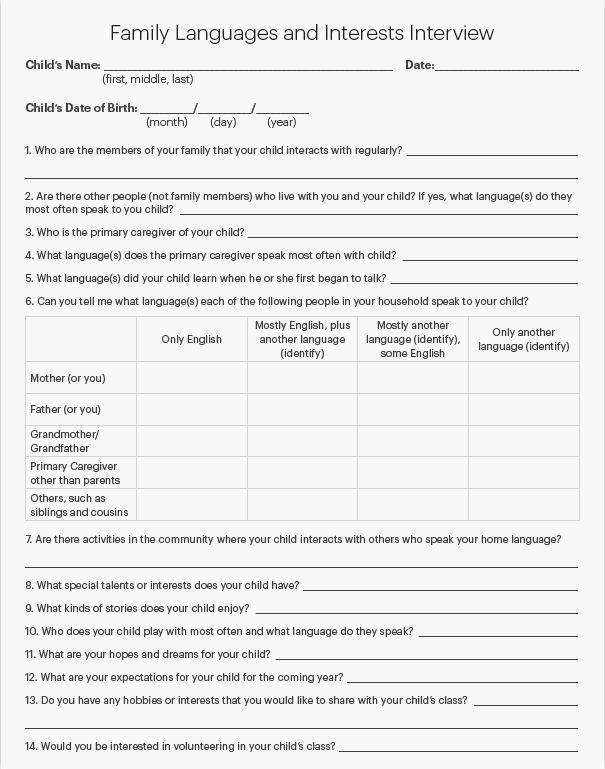
Transform your classroom into a rich setting with areas for children to talk and play, and with spaces for both quiet and active learning and small group interactions.
Here are some supports to use:
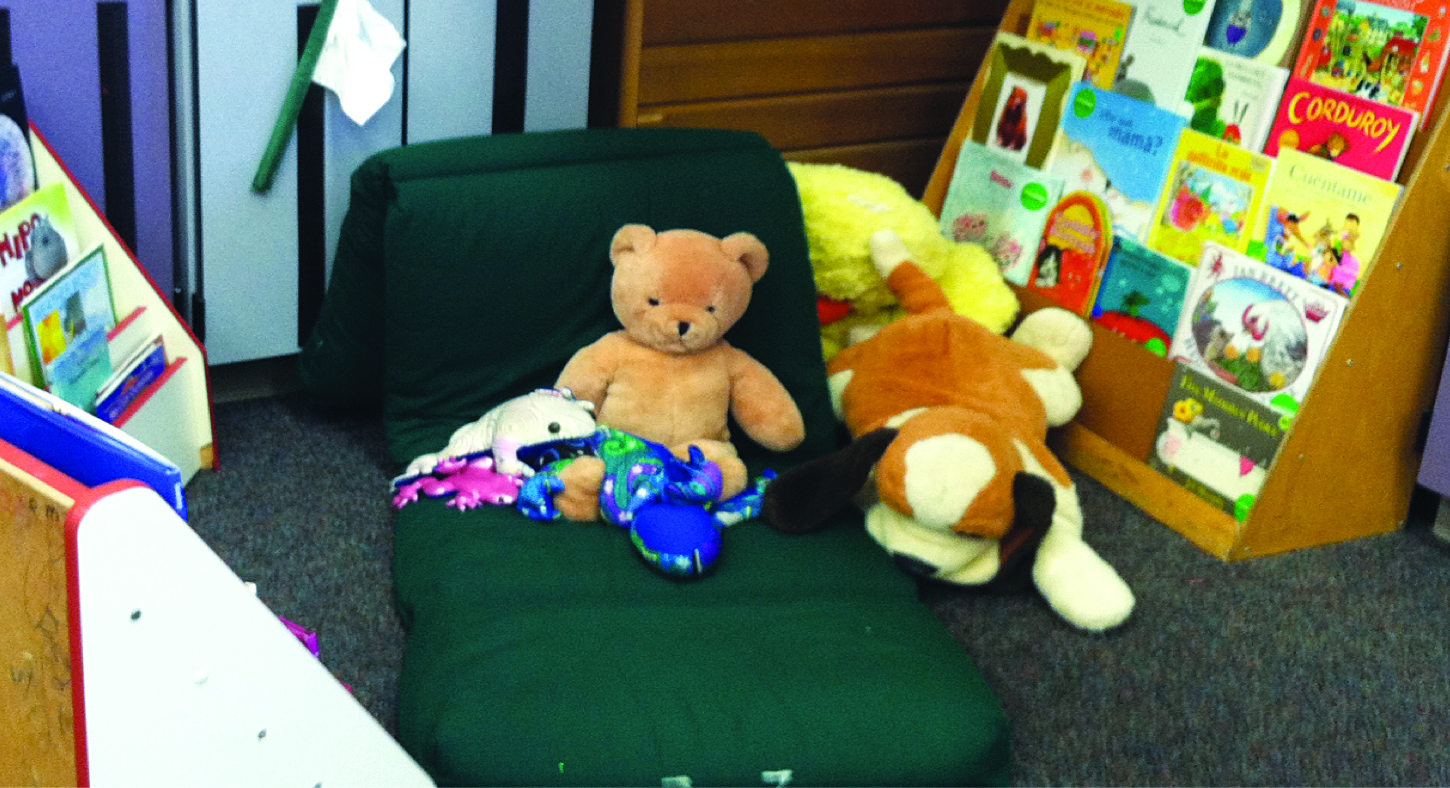
-
Label in each of the home languages of the children, with one color for each language used consistently throughout the classroom for schedules and topic displays. (Use an online translation tool, like Google Translate, and ask parents to help with specific words.)
-
Place environmental print in all the children’s home languages—everyday objects like magazines, food packaging, commercial products, etc.—throughout play areas and the classroom.
-
Display family photos, books, artifacts, and posters and other visuals from all the children’s cultural backgrounds throughout the classroom at child’s-eye level and in learning centers. Families are often eager to help supply the classroom with items from their home that represent family and cultural traditions, such as examples of artwork, empty food boxes, pictures, etc.
Teachers can work with librarians to select books in the children’s languages that relate to curricular themes and can adapt puzzles to include writing in all the children’s languages. Families can share songs, rhymes, and dichos (playful sayings) in all the languages of the children; they can also help stock the dramatic play area and art center with clothing and cultural artifacts from each child’s background.
Conclusion
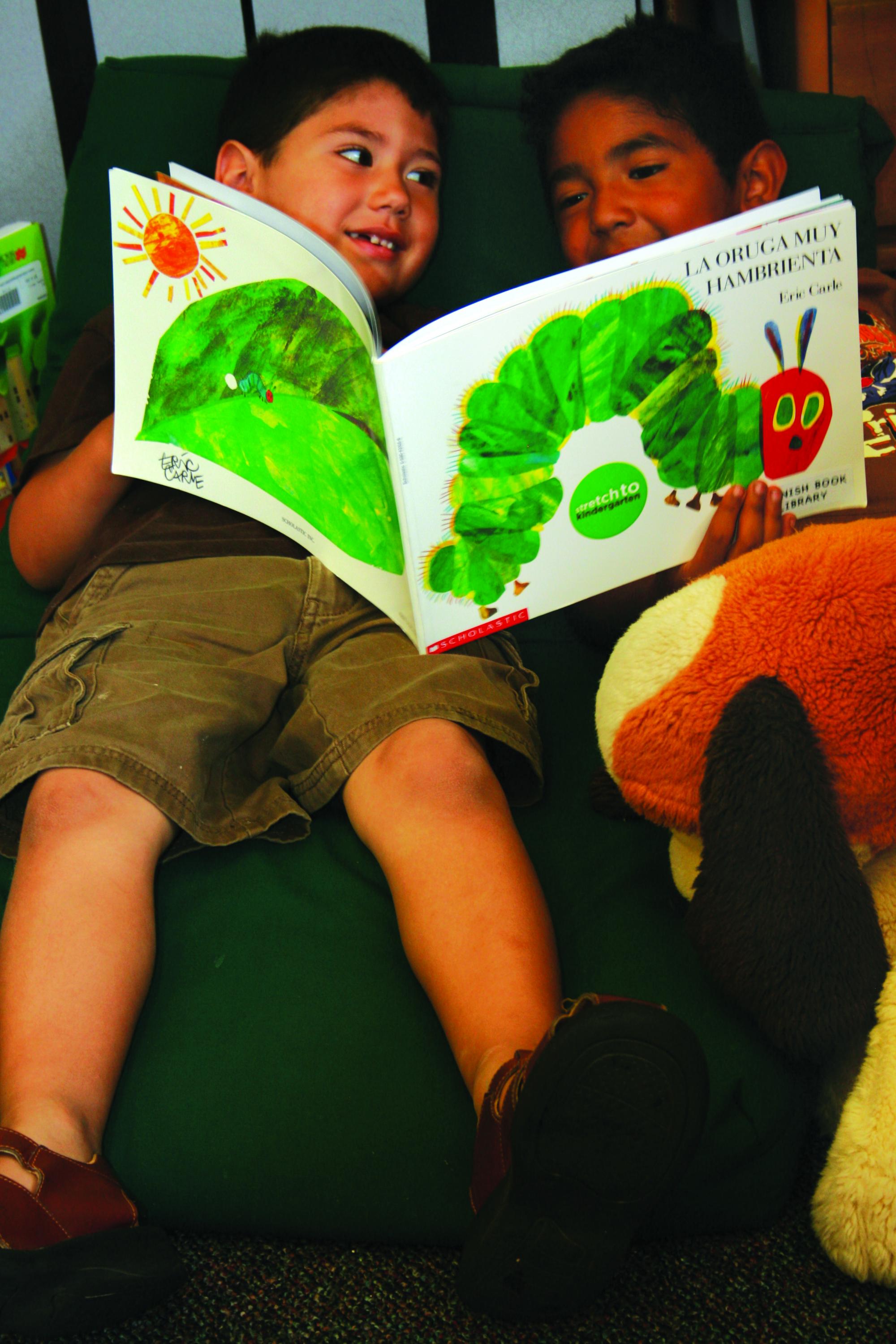 Without a doubt, fostering young dual language learners’ development of English and also of their home languages is a major challenge. But if you use the strategies outlined in this article, you can partner with families and create a responsive environment that supports each child and encourages learning.
Without a doubt, fostering young dual language learners’ development of English and also of their home languages is a major challenge. But if you use the strategies outlined in this article, you can partner with families and create a responsive environment that supports each child and encourages learning.
In the February/March 2019 issue of TYC, we’ll share even more strategies for linguistically appropriate instruction.
Two Classroom Language Models
In schools across the United States, many teachers who try to help children become bilingual use one of these two language models. Both work well with our POLL strategies. This article elaborates on the second one.
The fifty-fifty dual language model
Teachers make sure children experience (hear, speak, see in print, etc.) both English and their home language in all content areas (literacy, math, outdoor play, etc.). With careful planning, teachers ensure that children experience equal exposure to both languages and also provide a clear structure for language separation.
This is a great model for supporting emergent bilingual children, but it is most feasible when all of the children speak the same home language (e.g., Spanish). Two different home languages can also be supported in this model through careful allocation of time and other instructional resources. (For an example of a classroom that embraces English, Spanish, and Arabic, see “Conversations with Children,” by Janis Strasser.)
The English language development with home language support model
Teachers most often use this model when they are not proficient in the children’s home languages. It gives them a clear and consistent plan for when and how to use English and when and how to use the children’s languages. Children learn mainly in English during instructional time, but benefit from home language and multicultural supports that teachers intentionally interweave throughout the daily routine. For a description of specific supports to use, see the POLL strategies described in this article.
Note: This article builds on “Many Languages, One Teacher: Supporting Language and Literacy Development for Preschool Dual Language Learners,” by Elizabeth S. Magruder, Whitcomb W. Hayslip, Linda M. Espinosa, and Carola Matera, in the March 2013 issue of Young Children. Based on feedback we received from teachers, we expanded the strategies we described in that article to more fully support young dual language learners in attaining the benefits of full bilingualism.
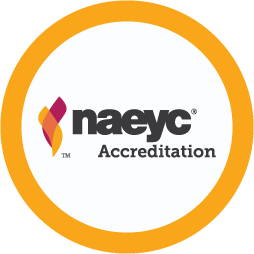
STANDARD 3: TEACHING
3B: Creating Caring Communities for Learning
3F: Making Learning Meaningful for All Children
Photographs: 1, 3 courtesy of Betsy Nikolchev; 2, courtesy of Carola Oliva-Olson
Carola Oliva-Olson is an associate professor at California State University Channel Islands. She supports dual language programs and offers professional development as an independent consultant.
Linda M. Espinosa an emeritus professor of early childhood education at the University of Missouri, Columbia, was a co-principal investigator for the Center for Early Care and Education Research–Dual Language Learners at the Frank Porter Graham Child Development Institute, the University of North Carolina at Chapel Hill.
Whit Hayslip served as the assistant superintendent for early childhood education in the Los Angeles Unified School District and currently consults for the David and Lucile Packard Foundation.
Elizabeth S. Magruder, a senior program associate at WestEd’s Center for Child and Family Studies, supports dual language professional development as an independent consultant.